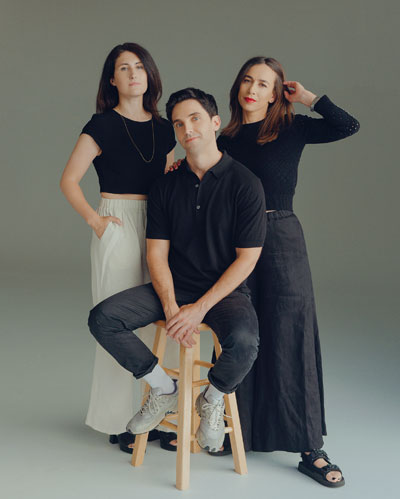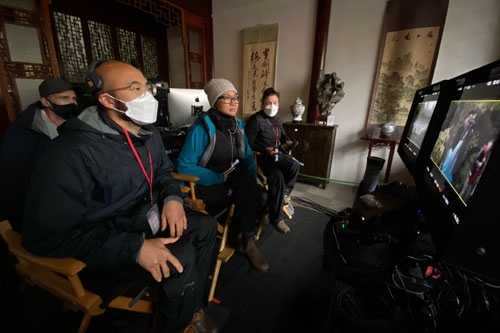The WGAW’s Committee of Women Writers (CWW) recently hosted a Zoom panel called Pitches That Sold—and Made It To Air, moderated by Kate Torgovnick May, with help from CWW co-chairs Andra Whipple and Jeane Wong. As the title promised, the writers meticulously reenacted the pitches that sold their projects for an audience of over 700 Guild members.
Written by listened in for tips that contributed to their success.
The Comedy
First up, Hacks co-creators Lucia Aniello, Paul W. Downs, and Jen Statsky gave their exact 2019 pitch, each taking turns speaking from their script. They started out centering on their diva-like star, Deborah Vance, describing her and her backstory in detail, before moving on to sketch out the other main characters. Almost halfway through, they introduced Ava, the young writer whom Deborah reluctantly hires to help improve her material. Both women have been dismissed by an industry all too eager to cast women aside.
 Hacks creators and showrunners Jen Statsky, Paul W. Downs and Lucia Aniello. Photo by Ryan Pfluger
Hacks creators and showrunners Jen Statsky, Paul W. Downs and Lucia Aniello. Photo by Ryan Pfluger“One person asked why it took so long to get to Ava even though it is a two-hander,” Downs said. “It’s because the character of Deborah is one that’s easily accessible…we were like, let’s make this one feel very idiosyncratic and specific, and they’ll have something to hang their hat on, before we get into someone who is less developed in their life because they’re 22.”
The creators mentioned the recent redemption stories of some real-life women—Monica Lewinsky, Anita Hill, Marcia Clark—and ended by noting that their show is the ultimate redemption story. They sold the show, mid-pitch, to HBO Max.
Torgovnick May: Any nerve tips?
Downs: I find that going off-script helps. There’s something about reading something or having it memorized that makes it high pressure. If it feels more conversational, and you can have some adlibbing, it feels like you’re in a room with people, which you are.
Statsky: When we were doing the pitch, we liked to riff about other stuff…
Downs: It also invites them to chime in and be a little more engaged.
Aniello: If you are pitching with a writing partner, even just making each other laugh and throwing in things that are new and different, so they’re laughing too, just makes everyone feel looser.
The Drama
Next up, Miranda Kwok (Spartacus, The 100) gave her memorized pitch for The Cleaning Lady, opening with her family’s moving immigration stories, and then linking them to that of her lead, Reyna (later renamed Thony).
 The Cleaning Lady showrunner Miranda Kwok on the WGA strike picket line at Warner Bros. Studios on June 27, 2023. Photo by Jerry Jerome
The Cleaning Lady showrunner Miranda Kwok on the WGA strike picket line at Warner Bros. Studios on June 27, 2023. Photo by Jerry JeromeShe jumped into the pilot’s thrilling opener: Reyna speeds down the Vegas strip, throws money out the window at a homeless encampment, talks to her child Luca on the phone, and winds up in the desert pointing a gun at a man pleading for his life.
Kwok then flashes back a year and touches on Reyna’s backstory, and her child’s rare illness, which led her from being an anesthesiologist in the Philippines to becoming a crime-scene cleaner for the Russian mob in Vegas.
Kwok likens the show’s tone to Breaking Bad, with the sassiness of Hustlers and the emotional underpinnings of This is Us. She jumps back into the pilot’s plot, and gives an overview of season 1, and then teases season 2, wrapping at about 25 minutes. Fox recently renewed The Cleaning Lady for its fourth season.
Torgovnick May: How did you learn how to give a pitch?
Kwok: I learned from winging it. The first time I pitched, I hadn’t heard a pitch, I hadn’t read a pitch, I was just trying to figure it out as I go. But this pitch was developed with Warner Bros., so as some people might recognize, it follows a classic Warner Bros. structure, which essentially is: You start with something personal about yourself, then you go into the teaser to grab their attention and give a feel of the show, then you go into the world and the characters and why you want to do the show. Then back to the pilot, then the season, then end with the tone. So they helped a lot in shaping this pitch with me.
Torgovnick May: Was there a moment where you were like, ‘I know this is going to happen.’
Kwok: I don’t think that I ever feel that confident, but I definitely felt an excitement in the room. I felt like I grabbed their attention and held it. You don’t always know; some people watching pitches are nervous themselves, so sometimes it’s hard to read them….Don’t try to read the room, just keep going, keep your energy and enthusiasm up, because that’s what’s going to sell it, your passion for the material.

Don’t try to read the room, just keep going, keep your energy and enthusiasm up, because that’s what’s going to sell it, your passion for the material.
- Miranda Kwok
The Feature
Adele Lim (Crazy Rich Asians) and fellow WGAW members Cherry Chevapravatdumrong and Teresa Hsiao came up with the story for Joy Ride together; Chevapravatdumrong and Hsiao wrote the spec screenplay, which Lionsgate bought. So Lim gave the pitch she used to get the movie officially greenlit, and to be hired as director.
After joking that Joy Ride is a movie with two hours of dick jokes, she launched into the pitch, sharing her screen to play the pitch deck she had created to sell the look, the feel, the sound, and the largely-unknown AAPI cast to the studio.
 Adele Lim on the set of Joy Ride. Photo by Lionsgate
Adele Lim on the set of Joy Ride. Photo by LionsgateAudrey, a young Asian woman raised by white parents, goes back to China accompanied by her messed-up friends to ostensibly close a business deal, before taking a wild, hilarious, and ultimately touching journey to find her birth mother, and, finally, herself. Joy Ride is a road trip adventure romp about finding herself, with the help of her ratchet friends, sort of like The Hangover and Girls’ Trip, with a soupçon of Bridesmaids thrown in. At about 20 minutes, ending on one very raunchy photo, the pitch was complete.
Torgovnick May: It’s so cool to get that insight on how you as a director are thinking about music, and how you’re going to showcase these different locations, and even how you want to use the actors’ skills in different ways.
Lim: It really was a different exercise, and the bummer was we had to pitch it during the pandemic, and there were so many restrictions, but the upside to it is that pictures really do say so much more, and being able to use it as a crutch, as a shorthand to sell the movie, was really helpful.
Torgovnick May: Do you have any rituals to get ready for the pitch and keep your energy up?
Lim: By this time I’ve been pitching for a while so I’m used to it. but early on when I was nervous…I would psych myself up, I’d listen to Kendrick Lamar in the car, and a key thing was, on the morning of, I would tell myself, ‘Fuck it, this is fantastic, they’re crazy if they don’t want this,’ and then kind of swan in with that energy.
Pitching Tips
All the panelists stayed for each other’s pitches, so Torgovnick May then directed questions to all of them. When she asked what they thought the three pitches had in common, Lim responded, “With all our stories, it’s kind of heartwarming and joyful because the cynical side of the industry would tell you that you could not sell these stories. You’re not going to sell this story about a washed-up hack, a cleaning lady from the Philippines, and four girls who are ratchet, with a big arc of the movie being one woman wanting to bang Stephon Marbury. And somehow there was an outlet for it all.”
Torgovnick May: If you had a choice, would you prefer to pitch in person or Zoom?
Lim: I used to be an in-person person for pitching. Since then I’ve pitched a number of projects on Zoom because we all use visuals now. Before, I used zero visuals. Now it’s so easy, saving on the commute, literally, parking and schlepping to the office, having the visuals does so much of the work for you.
Downs: You can read without it seeming like you’re reading over Zoom, but sometimes with a comedy it’s nice to have feedback in the room. I find the lack of laughter can make it feel scarier.
Torgovnick May: Do you have any Don’t’s while pitching?
Lim: Try not to pitch from a place of fear because it’ll make you do dumb things. It’ll make you nervous and put in way too much detail. A lot of writers think, but they could have these questions. They won’t not buy your show if they have a question—they’ll ask a follow up question.
Kwok: Do not leave material. That is because people respond to what they like, and they’ll remember the things they like, and that’s what they’ll repeat to whoever they have to pitch to. The moment you leave material, they’re looking at everything that is wrong about it, and looking to critique it. That’s the number one reason why you do not leave pages in the room with them.
Note: Leaving written material with a producer or a studio after a pitch is prohibited free work. The Guild has also heard reports of the Zoom record function being used to record and transcribe writers’ pitches over Zoom. Recording a person without their consent is unlawful. If you are asked to consent to a recording, you should refuse. Learn more.
If you are asked to leave behind work prior to employment, or if you believe that your Zoom pitch has been transcribed or recorded, please contact the Guild’s Contracts Department for assistance. The Guild may be able to pursue compensation on your behalf.






